外文翻译--用港口物流及供应链管理方法来评价港口绩效
- 格式:doc
- 大小:69.50 KB
- 文档页数:13

港口物流绩效评价方法浅析摘要:国内对港口物流绩效的研究还不是很成熟,但最近几年来已有很多学者开始从事这方面的研究,从一开始的港口发展到了港口物流的研究。
本文简要分析港口物流绩效评价方法,然而对港口物流绩效的研究大多只针对国内为数不多的港口进行研究,真正应用于港口还存在很大的困难。
关键词:港口;物流绩效;港口物流绩效一、港口物流绩效的基本内涵1、物流绩效关于物流绩效的定义一直都没有一个统一的结论。
大量文献中对物流绩效提出了许多不同的衡量尺度,包括效力、效率、质量、生产率、创新性、利润率以及预算性等。
恽伶俐给出的物流绩效的定义是:物流绩效是物流活动过程中一定量的劳动消耗和劳动占用与所符合社会需要的劳动成果的比例。
keebler对物流绩效的定义给出了5项建议:(1)研究者们需要更加明确绩效指标的定义与缺陷;(2)更多地具有创新性的研究应对企业财务绩效评价体系进行补充;(3)物流绩效评价动态模型需要进行开发,以适应由行业、企业以及产品变革所引起的绩效衡量尺度的变化;(4)应该考虑在供应链下进行绩效评价,而不是单纯地对单个企业进行评价;(5)需要建立理论与实践相联接的桥梁。
2、港口物流绩效与前文中所给出的物流绩效五项建议的定义结合,本文将港口物流绩效定义为:港口物流绩效评价指的是对港口硬件水平、经营管理水平、客户满意度等特定的港口物流软硬件条件和服务水平以及运作环节数据的采集、整理、分类、分析、解释和传播,采取相应的评价模型和评价计算方法,来对以往行为的效力或效率进行量化,做出的客观、公正和准确的评判,并据此做出相应决策,采取相应行动的过程和结果。
港口物流绩效评价具有静态性与动态性;可组合性与可分解性;完整性与开放性等特点,其中物流绩效可以是一个静态评价结果,也可以是一个产生该结果的动态活动过程。
两者既可以单独作为指标进行考核,也可以同时进行评价。
可见,港口物流绩效的衡量实质是对港口物流环节中的硬件能力、经营管理能力以及服务能力的考量,只有硬件能力强才能吸引更多大型公司以及大宗货物的靠泊,能提供良好的服务才能揽的更多的货物,只有良好的经营管理能力,利用先进的物流技术,才能提高其运作效率。
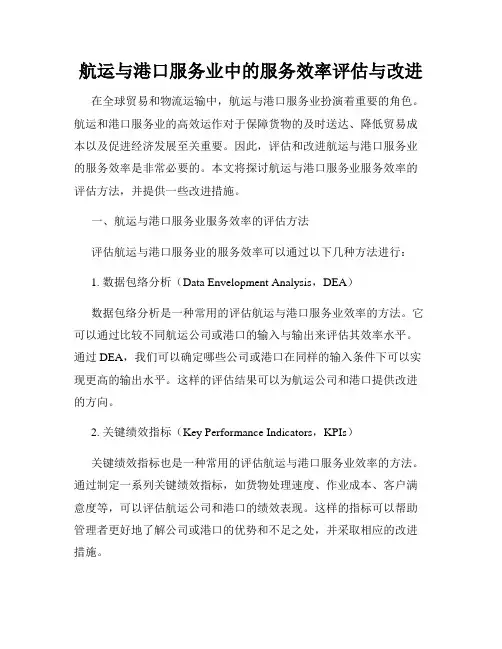
航运与港口服务业中的服务效率评估与改进在全球贸易和物流运输中,航运与港口服务业扮演着重要的角色。
航运和港口服务业的高效运作对于保障货物的及时送达、降低贸易成本以及促进经济发展至关重要。
因此,评估和改进航运与港口服务业的服务效率是非常必要的。
本文将探讨航运与港口服务业服务效率的评估方法,并提供一些改进措施。
一、航运与港口服务业服务效率的评估方法评估航运与港口服务业的服务效率可以通过以下几种方法进行:1. 数据包络分析(Data Envelopment Analysis,DEA)数据包络分析是一种常用的评估航运与港口服务业效率的方法。
它可以通过比较不同航运公司或港口的输入与输出来评估其效率水平。
通过DEA,我们可以确定哪些公司或港口在同样的输入条件下可以实现更高的输出水平。
这样的评估结果可以为航运公司和港口提供改进的方向。
2. 关键绩效指标(Key Performance Indicators,KPIs)关键绩效指标也是一种常用的评估航运与港口服务业效率的方法。
通过制定一系列关键绩效指标,如货物处理速度、作业成本、客户满意度等,可以评估航运公司和港口的绩效表现。
这样的指标可以帮助管理者更好地了解公司或港口的优势和不足之处,并采取相应的改进措施。
3. 服务质量评估除了评估效率,评估航运与港口服务业的服务质量也是非常重要的。
服务质量评估可以通过客户满意度调查、投诉处理情况、服务响应时间等指标进行。
了解客户对于航运公司和港口服务的满意程度可以帮助它们发现潜在的问题并进行改进。
二、航运与港口服务业服务效率的改进措施根据航运与港口服务业的评估结果,可以采取以下一些改进措施来提升服务效率:1. 投资于先进技术与设备航运公司和港口可以考虑投资于先进的技术和设备,以提高货物处理速度和效率。
例如,引入自动化装卸设备可以减少人力成本并提高作业效率。
同时,建立信息化系统可以实现货物跟踪和库存管理的自动化,减少人为错误和提高工作效率。
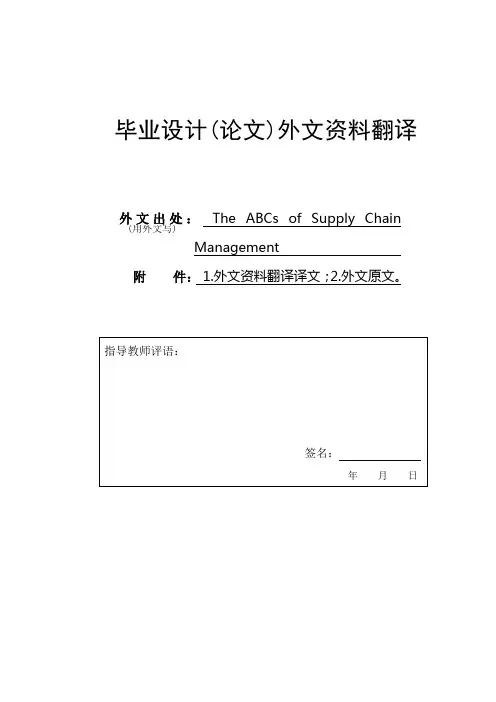
毕业设计(论文)外文资料翻译外文出处:The ABCs of Supply Chain (用外文写)Management附件:1.外文资料翻译译文;2.外文原文。
附件1:外文资料翻译译文供应链管理ABC1.什么是供应链管理供应链是一种关于整合的科学和艺术,它主要探究提高企业采购生产商品所需的原材料、生产商品,并把它供应给最终顾客的效率的途径。
以下是供应链管理的五个基本组成模块:计划--它是供应链的战略层面。
企业需要有一个控制所有资源的战略以满足客户对产品或服务的需求。
计划的核心是建立一套机制去监控整条供应链以便使它能有效运作:低成本、高品质配送和增值客户服务。
该模块连结着供应链的作业与营运目标,主要包括需求/供给规划(Demand/Supply Planning)与规划基础建设(infrastructure)两项活动,对所有采购运筹流程、制造运筹流程与配送运筹流程进行规划与控制。
需求/供给规划活动包含了评估企业整体产能与资源、总体需求规划以及针对产品与配销管道,进行存货规划、配送规划、制造规划、物料及产能的规划。
规划基础建设管理包含了自制或外包决策的制定、供应链的架构设计、长期产能与资源规划、企业规划、产品生命周期的决定、新旧产品线规划与产品线的管理等。
采购—选择供给你提供用来生产产品或服务的原材料或服务的供应商。
和供应商建立一套价格、供应、支付过程的体系,创造一种机制以监控此过程、改善供应商关系。
理顺此过程以管理供应商交付的原材料库存或服务,其中包括收货、出货、检验、中转和批准支付。
此模块有采购作业与采购基础建设两项管理活动,其目的是描述一般的采购作业与采购管理流程。
采购作业包含了寻找供货商、收料、进料品检、拒收与发料作业。
采购基础建设的管理包含了供货商评估、采购、运输管理、采购品质管理、采购合约管理、付款条件管理、采购零组件的规格制定。
制造—这是制造步骤。
计划这些必需的活动:生产、测试、包装、预出货。

港口的员工绩效如何科学评估在港口的日常运营中,员工的绩效评估是一项至关重要的管理工作。
科学合理的绩效评估不仅能够激励员工提高工作效率和质量,还能为港口的发展提供有力的人力支持。
那么,如何对港口的员工绩效进行科学评估呢?首先,我们需要明确评估的目标和标准。
评估的目标应该与港口的整体战略目标相一致,例如提高货物吞吐量、降低运营成本、提升服务质量等。
基于这些目标,制定具体、可衡量、可实现、相关且有时限的(SMART)评估标准。
对于操作岗位的员工,比如装卸工人,其绩效标准可以包括装卸货物的数量和质量、操作的安全性、设备的维护情况等。
对于管理人员,如调度员,绩效标准可能涵盖调度计划的准确性和及时性、资源分配的合理性、应对突发情况的能力等。
对于技术人员,像工程师,标准可以是设备故障的排除效率、技术创新的成果等。
在确定评估标准后,选择合适的评估方法至关重要。
常见的评估方法有以下几种:一是关键绩效指标法(KPI)。
通过设定关键绩效指标,对员工的工作表现进行量化评估。
例如,对于港口的起重机司机,可以将每月吊起的货物吨数、操作失误次数等作为关键绩效指标。
二是360 度评估法。
从多个角度对员工进行评估,包括上级、同事、下属甚至客户。
这种方法能够全面了解员工的工作表现,但操作相对复杂,需要确保评估者的客观性和公正性。
三是目标管理法。
与员工共同制定工作目标,然后根据目标的完成情况进行评估。
这种方法能够激发员工的主动性和自我管理能力。
评估的频率也是需要考虑的一个因素。
过于频繁的评估可能会增加管理成本和员工的压力,而评估间隔过长则可能无法及时反馈员工的工作表现。
一般来说,对于基层员工,可以每月或每季度进行一次评估;对于管理人员,可以每半年或一年进行一次评估。
在评估过程中,收集准确、全面的绩效数据是关键。
这需要建立完善的数据收集系统,包括工作记录、监控设备数据、客户反馈等。
例如,通过港口的作业管理系统记录装卸工人的作业量和时间,通过客户满意度调查获取对服务人员的评价。

港口物流绩效评估与优化研究近年来,随着物流行业的不断发展以及国际经贸的日益繁荣,港口物流成为了连接国际贸易和内陆运输的重要枢纽,对于提高国家的贸易竞争力、优化资源配置、促进经济发展起到了至关重要的作用。
然而,港口物流运作过程中存在效率低下、资源浪费、运作成本过高等问题,如何评估港口物流绩效并进行优化研究,已成为当前行业内亟待解决的问题之一。
一、港口物流绩效评估模型港口物流绩效评估是港口物流优化的前提和保障,评估过程需要考虑多种因素,如货运流量、运输成本、操作效率等。
对于港口物流企业来说,绩效评估旨在评估各个业务环节的运营效率,以及识别业务中存在的风险和问题,从而制定合理的优化措施,提高港口物流运作效率和降低成本。
根据以上考虑的因素,建立港口物流绩效评估模型,可以从物流成本、货运量、设备利用率等各个方面来反映港口物流的绩效。
物流成本方面,港口物流企业可通过公式:总成本=运营成本+固定成本+管理成本,来评估港口物流运营成本的结构和水平。
货运量方面,可通过公式:货物吞吐量*货物单价=货运量,来评估物流业务的运输量和价值。
设备利用率方面,可通过公式:设备运转时间/设备开放时间=设备利用率,反映设备利用率的高低程度。
以上公式可看作是港口物流绩效评估的理论基础,通过建立多个因素的评估模型,并综合考虑各个方面的因素,来评估港口物流的绩效水平。
二、港口物流优化案例分析港口物流优化是一项长期、复杂的过程,需要综合考虑多种因素,并根据实际情况制定相应的优化措施。
以下是江苏某港口的物流优化案例分析。
一是改造前某钢铁企业采用大型车辆进出口岸,车辆进出企业速度缓慢,单日处理运输量极低。
后改为小型车辆进出口岸,不仅提高了车辆进出企业的速度,还增加了港口物流运输的普及率,提升了整个港口物流的效益。
二是借助AI技术对港口物流的各个环节进行优化。
以江苏某港口为例,利用人工智能技术对货运队列、船舶、码头和传统物流作业进行智能识别,则可以实现对船舶停靠的货物进行识别和自动化,提高了港口物流的处理能力和效率。

港口物流的质量管理及定量评估方法港口物流是现代物流业的重要组成部分,承担着货物进出口、储存、加工、运输等多重职能,保障着全球贸易链的顺利运转。
而港口物流的质量管理是保证港口物流服务质量和运作效率的重要手段。
本文将探讨港口物流的质量管理意义、存在的问题以及定量评估方法。
一、港口物流的质量管理意义港口物流的质量直接影响着港口的形象和声誉,也是影响港口竞争力的重要因素。
质量管理可以明确服务标准、要求流程规范、优化服务流程,提高服务效率,增强客户满意度,从而提高港口的市场竞争力。
另外,随着物流业发展和技术的普及,客户对港口物流服务的要求也越来越高,环境法规的不断完善对港口的要求也越来越苛刻。
港口物流的质量管理不能仅仅停留在传统的质量检测和认证,而应采用更细致、全面、科学的质量管理方法,推动港口物流业的可持续发展。
二、港口物流质量管理存在的问题1.质量标准不统一。
港口物流涉及多种服务对象和行动,而各服务对象的对质量标准的要求存在明显差异,标准不统一成为港口物流质量管理的难点之一。
2.信息不透明。
港口涉及多个部门和单位,信息分散且不透明,而质量管理需要建立信息共享机制,对信息的采集、分析、应用和反馈进行全面管理和掌控。
3.管理缺乏科学化和规范化。
传统的管理方式多采用经验主义,未能采用科学化和规范化的管理手段,管理效率较低。
三、港口物流质量管理定量评估方法港口物流质量管理定量评估方法是评价港口物流质量管理水平、发现问题并进行改进的一种有效途径。
具体方法如下:1.质量评估指标体系的构建。
从质量、速度、成本、服务、环境等多个维度构建指标体系,量化评估港口物流质量。
2.数据采集和处理。
建立港口物流信息平台,采集多种数据,包括货物流出入量、流量变化、客户满意度等等,对数据进行处理和分析。
3.评估结果的分析和反馈。
对评估结果进行分析,寻找问题和优势点,并对问题提出改进建议,反馈给港口物流中心和相关部门。
4.质量管理改进。
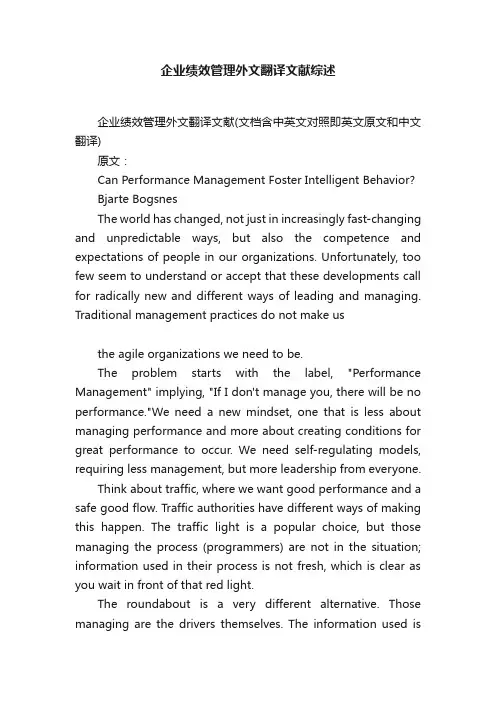
企业绩效管理外文翻译文献综述企业绩效管理外文翻译文献(文档含中英文对照即英文原文和中文翻译)原文:Can Performance Management Foster Intelligent Behavior?Bjarte BogsnesThe world has changed, not just in increasingly fast-changing and unpredictable ways, but also the competence and expectations of people in our organizations. Unfortunately, too few seem to understand or accept that these developments call for radically new and different ways of leading and managing. Traditional management practices do not make usthe agile organizations we need to be.The problem starts with the label, "Performance Management" implying, "If I don't manage you, there will be no performance."We need a new mindset, one that is less about managing performance and more about creating conditions for great performance to occur. We need self-regulating models, requiring less management, but more leadership from everyone.Think about traffic, where we want good performance and a safe good flow. Traffic authorities have different ways of making this happen. The traffic light is a popular choice, but those managing the process (programmers) are not in the situation; information used in their process is not fresh, which is clear as you wait in front of that red light.The roundabout is a very different alternative. Those managing are the drivers themselves. The information used isreal time, coming from own observations. While that information is also available in front of the traffic light, drivers do not have the authority to act on it. By the way, the "zipper" or "every second car through" is not a rule, but a guiding principle.The roundabout normally is more efficient than the traffic light, because of two significant differences in the decision-making process, information and authority. A third element is also required for the roundabout to be more efficient: while the traffic light is a simple-rulesbased system, the roundabout is values-based. A value-set based on, "Me first, I don't care about the rest," is not a big a problem in front of the red light, but is a serious problem in a roundabout. Here, a positive common purpose of wanting a safe and good flow is critical. Drivers must be more considerate, open about own intentions while trying to understand the intentions of peers. Instead of managing performance, traffic authorities have created conditions for self-managed performance to occur.What would the implications be for the loathed performance review? The principles and practices described at Return Path are sensible and interesting. I like the concept of horizontal commitments toward peers, instead of vertical commitments to higher management. At the same time, we need to broaden our definition of performance. In traditional performance, a commitment is too often about "hitting the number." This is too narrow. We need to ask questions such as, how are we doing compared to peers? How are we using KPIs to reflect on performance, or using hindsight and management assessment to verify results? Did we really move toward our longer-term ambitions? How sustainable are the results? Last but not least, there has to be room for values if performance systems are tofoster intelligent behavior; we need to ask, how where those results achieved?At Statoil our integrated performance management approach links ambitions to actions. Our targets reflect a broad set of ambitions,including people, health, safety, environment, operations and financial performance. Read more about our management model and how we apply a holistic and values-based approach to this broader performance agenda.The words of Dee Hock, former GEO of Visa, should guide the design of our management processes, including our performance reviews: "Simple, clear purpose and principles give rise to complex, intelligent behavior. Complex rules and regulations give rise to simple, stupid behavior."While researching my book. Talent Economics, I interviewed employees about what really motivates today's workforce. I discovered a disconnect between the performance support my interviewees wanted versus how managers recounted their contribution to these conversations.Over the last 20 years, the employee mindset has evolved faster than has the art and science of management. Nowhere is this starker than in the area of performance management practices, particularly the annual review. In both the developed and developing world, employees report that this end-of-year activity breeds stress, anxiety and mistrust. How ironic that a process aimed at improving organizational performance, is itself underperforming!It's time to "reboot" our performance management operating system, installing two specific system updates: l. The "Democracy" update. As much as we try to make theperformance appraisal a two way dialogue, we cannot run away from the fact that at its core, the conversation today is often a top-down review. My research shows that many 21st century employees are rejecting conversations that are one-way: in hot job markets today, managers must realize "who is appraising whom." With other offers readily available, many employees enter a performance dialogue privately considering if their manager is worth another year of their career. The performance management conversation now reflects a company's Employee Value Proposition, much as we learn in the lead Perspective.The Democracy update means that managers only gain the right to give feedback when they first genuinely seek the same on their own performance as leaders. Not just through 360-degree reviews, but also through authentic conversations asking, "How am I performing as your manager? " and "How can I help you succeed?" Only then can the conversation shift to, "How you can improve?"and "This is what you should focus on."2. The Success module. Greater employee autonomy and empowerment also changes the meaning of management. We have gone from a "supervisor of task and outcomes" to an "enabler of performance, innovative thinking and collective success." To make this shift, we must give up the judge's robes for the coach's uniform. If employees don't succeed, managers are on the hook, too.This is particularly relevant when coaching a team to success. People bring different skills to a team and how well they work together really matters. If team reviews work better to achieve a goal, so be it. The Return Path story illustrates how review processes can be designed and executed around what matters most, and where everyone dons the uniforms of player and coach.What if, instead of making the heart of a performance conversation the evaluation, it became a vehicle to improve success of the individual, the team and the business? What if performance feedback was paired with dialogue about transforming the business, the product or customer experience? This genuinely reboots and upgrades performance management to focus on individual and organizational success.It is indeed time to upgrade performance management practices: we can no longer manage a 21st century employee using 20th century mindsets.People & Strategy. 2013, V ol. 36 Issue 2, p12-13. 2p.译文:绩效管理能促进自我管理行为吗?Bjarte Bogsnes世界随着时间的推移而变化莫测,连那些与时变化而不可预测的通道也随之改变,与此同时组织人员的能力和期望也顺应时代潮流。
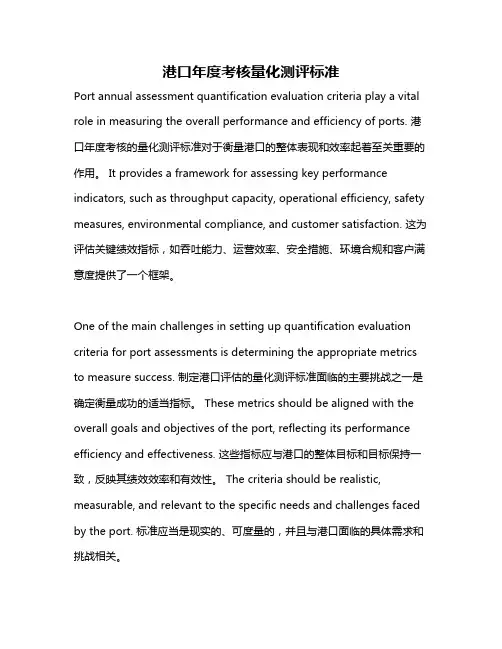
港口年度考核量化测评标准Port annual assessment quantification evaluation criteria play a vital role in measuring the overall performance and efficiency of ports. 港口年度考核的量化测评标准对于衡量港口的整体表现和效率起着至关重要的作用。
It provides a framework for assessing key performance indicators, such as throughput capacity, operational efficiency, safety measures, environmental compliance, and customer satisfaction. 这为评估关键绩效指标,如吞吐能力、运营效率、安全措施、环境合规和客户满意度提供了一个框架。
One of the main challenges in setting up quantification evaluation criteria for port assessments is determining the appropriate metrics to measure success. 制定港口评估的量化测评标准面临的主要挑战之一是确定衡量成功的适当指标。
These metrics should be aligned with the overall goals and objectives of the port, reflecting its performance efficiency and effectiveness. 这些指标应与港口的整体目标和目标保持一致,反映其绩效效率和有效性。
The criteria should be realistic, measurable, and relevant to the specific needs and challenges faced by the port. 标准应当是现实的、可度量的,并且与港口面临的具体需求和挑战相关。
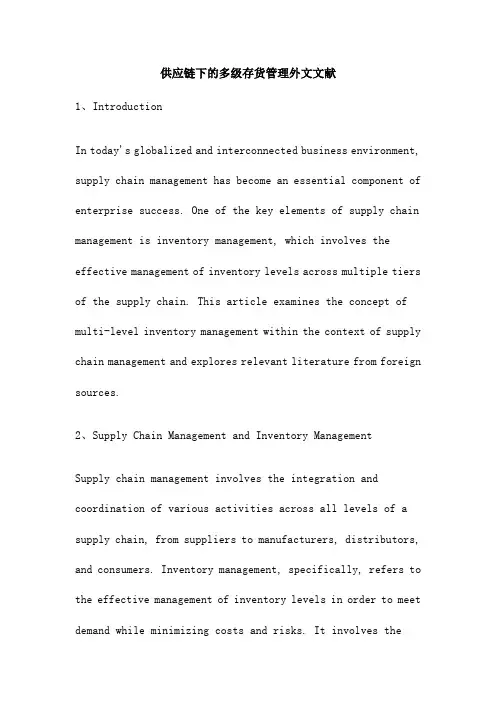
供应链下的多级存货管理外文文献1、IntroductionIn today's globalized and interconnected business environment, supply chain management has become an essential component of enterprise success. One of the key elements of supply chain management is inventory management, which involves the effective management of inventory levels across multiple tiers of the supply chain. This article examines the concept of multi-level inventory management within the context of supply chain management and explores relevant literature from foreign sources.2、Supply Chain Management and Inventory ManagementSupply chain management involves the integration and coordination of various activities across all levels of a supply chain, from suppliers to manufacturers, distributors, and consumers. Inventory management, specifically, refers to the effective management of inventory levels in order to meet demand while minimizing costs and risks. It involves theidentification of demand patterns, the determination of appropriate inventory levels, and the implementation of policies and procedures to ensure that inventory is rotated and utilized effectively.3、Multi-Level Inventory Management in the Supply ChainMulti-level inventory management refers to the management of inventory across multiple tiers or levels within a supply chain. It involves the coordination and synchronization of inventory levels across different stages of the supply chain to ensure efficient flow of goods and materials. By managing inventory at multiple levels simultaneously, enterprises can optimize overall inventory levels while ensuring that each tier of the supply chain is able to meet demand.4、Foreign Literature Review on Multi-Level Inventory ManagementA review of foreign literature on multi-level inventory management reveals a growing body of research on this topic. Studies have focused on various aspects of multi-levelinventory management, including demand forecasting, inventory policies, and supply chain coordination. Notably, research has shown that multi-level inventory management can significantly improve overall supply chain performance by reducing costs and increasing efficiency.5、ConclusionThe concept of multi-level inventory management within the context of supply chain management has gained significant attention in recent years. A review of foreign literature suggests that effective multi-level inventory management can lead to significant improvements in overall supply chain performance by optimizing inventory levels across different stages of the supply chain. Enterprises that adopt multi-level inventory management strategies can expect to achieve cost savings, increased efficiency, and a more robust supply chain overall.6、Recommendations for Future ResearchDespite the growing body of research on multi-level inventorymanagement, there are still several areas that require further exploration. Future research could focus on developing more advanced demand forecasting techniques to improve accuracy and reduce demand uncertnty. Additionally, studies could investigate novel inventory policies and strategies that can further optimize inventory levels across different tiers of the supply chn. Finally, research could also examine the role of technology in supporting multi-level inventory management, including the use of artificial intelligence, big data analytics, and other emerging technologies.供应链管理外文翻译供应链管理是一种全面的管理方法,旨在优化供应链的运作,提高效率和竞争力。

港口物流供应链管理的绩效评估与优化近年来,随着国内外贸易的快速发展,港口物流供应链管理也变得越来越重要。
港口在国际贸易中扮演着重要的角色,它是货物进出口的交汇点,也是物流运输的枢纽。
因此,港口物流供应链管理的绩效评估与优化尤为关键。
港口物流供应链管理的绩效评估是指对港口物流供应链各个环节进行全面、客观、科学的衡量与分析,从而发现问题并提出改进措施的过程。
这个过程涉及到港口的运输、仓储、装卸、配送等环节,需要考虑到各个环节的效率、成本、质量等因素。
首先,评估港口物流供应链的运输环节。
港口作为进出口货物的枢纽,运输环节是港口物流供应链的核心环节。
评估时需要考虑运输的效率、准时性以及物流成本。
运输环节的效率可以通过货运量、船舶停泊时间等指标来衡量,准时性则需要考虑到装卸作业的及时性以及运输的节点协调性。
同时,物流成本也是评估运输环节重要的指标之一,需要综合考虑航运费用、燃油成本等方面。
其次,评估港口物流供应链的仓储环节。
仓储是港口物流供应链中非常重要的环节,它影响着货物的存储、分配和调度。
在评估仓储环节时,需要考虑仓库的利用率、货物的安全性、货物信息的及时性等因素。
仓库的利用率高低可以通过货物堆放密度、仓库周转率等指标来评估,货物的安全性则需要考虑到防火、防盗等方面。
同时,货物信息的及时性对于供应链管理也至关重要,它关系到货物的跟踪、配送等环节。
另外,评估港口物流供应链的装卸环节。
装卸环节是港口物流供应链中非常关键的环节,它涉及到货物进出口的流程和效率。
评估装卸环节时需要考虑到装卸作业的效率、安全性以及装卸设备的使用率等因素。
装卸作业的效率可以通过货物处理能力、装卸时间等指标来评估,安全性则需要考虑到货物的受损率、作业人员安全等方面。
此外,装卸设备的使用率也是一个重要的指标,它关系到设备的利用效率和成本。
最后,评估港口物流供应链的配送环节。
配送环节是港口物流供应链中货物最后一个环节,它直接关系到货物的交付和客户满意度。
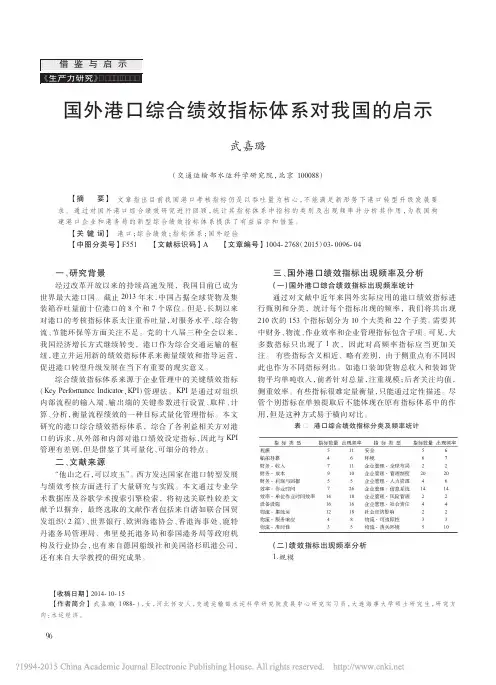
物流外包_外文翻译稿加原稿译文题目: 物流外包—确保一个组织竞争优势的一种手段外文题目: Logistics Outsourcing—A Means Of Assuring TheCompetitive Advantage For An Organization 出处: VADYBA MANAGEMENT 2007 m Nr 2 15 29作者: Loretta Parashkevova 译文:摘要物流方式表明将交付供应链中的独立单位整合成一个统一的系统的目标,完成结果所需的时间和资源的损失降到最小的材料和信息流动的直接管理。
一个最新方法的实施为公司的物流管理提供更多的成效,这个方法就是外包。
物流外包带来诸多好处,如:减少库存、减少订单的交货时间、提高运输质量、扩大生产的灵活性、降低生产成本和加速资金周转等。
这保证了较低的生产成本和更好的质量交付,这是一个决定性的竞争优势。
物流外包的应用有利于资源的合理配置,这是公司拥有的独特的竞争优势。
因此,物流外包将作为一种手段应用于公司的物流运输中,以确保一个组织的竞争优势。
关键词:外包,物流,供应商1.简介竞争优势,与不断增长的全球化和创新,开始逐渐失去其创意和新的竞争优势,在前端的灵活性,订单到交货时间减少,可靠的高质量的交付,和选择的机会。
在竞争领域,厂家的能力加入其生产过程和系统的规划与个人消费者的喜好,将是一个的决定性的因素。
只有通过建立灵活的生产管理系统,与个别客户订单问题的解决方案才是可能的。
首先,它需要的新的或最新的概念,如CFM(以客户为中心的制造),SCM(供应链管理),基于相同的概念作为企业资源规划(ERP),客户关系管理技术,生产管理的实施(客户关系管理)等,也将要求供应处理,物流中介机构的互动为基础的生产和有效的分配同步。
其次,它在微观和宏观层面上是一个必要的优化运输系统。
复杂的运输基础设施的发展是基于标准化的商品,货物,运输方式,装卸货物,交货速度,拓宽道路和铁路网络,完善的售后服务维修。
2016年9期总第816期一、引言近年来惠州港口快速的发展,已经让港口物流量大大提升,同时为惠州的经济发展起到非常重要的作用,提出海-空港“双港”战略模式,借鉴其他港口的做法“以港兴市”,“在更高的平面上布局惠州、以更高的规范来建设港口,加快惠州港口物流业的发展,从而带动其他产业经济。
因此,在促进城市发展的进程中港口物流的发展成了重点发展对象,如何评价港口物流企业在运行中是否有效,其绩效评价是衡量港口物流企业的发展现状有效途径,使用合适的评价指标和方法全面、客观的对物流企业绩效评价不仅有利于物流企业及时向正确的方向调整,而且利于合理配置资源,从而可以提高物流企业的运行效率,提升港口物流服务水平,增强港口竞争力,协调上下游供应链上各环节的发展,提升惠州在珠三角中的优势。
二、理论模型所谓港口物流企业绩效评价,主要看其投入与产出比,即在减少产出的情况,是否做到了成本最少化,或投入不变时是否效益最大化。
目前有不少学者从不同角度对港口物流企业绩效进行了研究。
如Liu 采用借助随机边界函数分析(SFA)建立了港口企业效率评价模型,杨静蕾等人采用层次分析法(AHP)。
吉阿兵和朱道立引入超效率数据包络分析模型。
杨华龙,Tongzon、Min 等人引入数据包络分析(DEA)模型并加以改进。
但后者运用于对国际集装箱港口的效率进行了评价,叶伟媛提出了主成分分析法。
刘彩芳(2011)运用DEA-AHP 分析法研究港口物流绩效评价。
其中DEA 方法用线性规划来判断评估指标对应的点是否有效,同时又可获得其他许多有用的信息,以便管理者从中判断做出正确决策。
在输入(认为越小越好)和输出(认为越大越好)的数据基础上,用各个决策单元偏离程度来对决策单元进行评价,其优点还在于其很强的客观性和实用性。
1.数据包络分析法DEA1978年Chames 和W.W.Coope 等人创建数据包络分析(Data Envelopment Analysis,DEA),并给出了第一个模型(CCR)。
中文4400字本科毕业论文外文翻译外文题目:A logistics and supply chain management approach to port performance measurement出处:MARIT. POL. MGMT作者:Khalid Bichou and Richard Gray原文:A logistics and supply chain management approach toport performance measurementBy Khalid Bichou and Richard GrayMARIT. POL. MGMT2004VOL. 31, NO. 1, 47–67ABSTRACTAlthough there is widespread recognition of the potential of ports as logistics centres, widely accepted performance measurements for such centres have yet to be developed. The essence of logistics and supply chain management is an integrative approach to the interaction of different processes and functions within a firm extended to a network of organizations for the purpose of cost reduction and customer satisfaction. The logistics approach often adopts a cost trade-off analysis between functions, processes and even supply chains. This approach could be beneficial to port efficiency by directing port strategy towards relevant value-added logistics activities. This paper seeks to show that through conceptualizing ports from a logistics and supply chain management approach, it is possible to suggest a relevant framework of port performance. A proposed framework is tested in a survey of port managers and other international experts.IntroductionMeasures of port efficiency or performance indicators use a diverse range of techniques for assessment and analysis, but although many analytical tools and instruments exist, a problem arises when one tries to apply them to a range of ports and terminals. Ports are very dissimilar and even within a single port the current or potential activities can be broad in scope and nature, so that the choice of an appropriate tool of analysis is difficult. Organizational dissimilarity constitutes a serious limitation to enquiry, not only concerning what to measure but also how to measure. Furthermore, the concept of efficiency is vague and proves difficult to apply in a typical port organization extending across production, trading and service industries.Ports have an important role to play in the integration of all three types of channel. There are many organizations occupied (or potentially occupied) with logistics and supply chain integration within and around ports, mainly in the role of logistics channel facilitators (ocean carriers, land-based carriers, port operators, freight forwarders, port agents, etc.), but also as public institutions such as Customs authorities. This paper seeks to adopt an approach that incorporates within a valid framework of analysis existing measures of port performance and efficiency, the association of ports with logistics and supply chain management, and appropriate measures of logistics and supply chain management efficiency.Background literaturePort performance and efficiencyUNCTAD suggests two categories of port performance indicators: macro performance indicators quantifying aggregate port impacts on economic activity,and micro performance indicators evaluating input/output ratio measurements of port operations. In this paper, we focus on the micro level. Various references, particularly UNCTAD monographs, provide a range of port indicators by ratio type and category of operation. There are many ways of measuring port efficiency or productivity, although reducible to three broad categories: physical indicators, factor productivity indicators, and economic and financial indicators. Physical indicators generally refer to time measures and are mainly concerned with the ship (e.g. ship turnaround time, ship waiting time, berth occupancy rate, working time at berth).Sometimes, coordination with land modes of transport is measured, e.g. cargo dwell time or the time elapsed between cargo being unloaded from a ship until it leaves the port.Factor productivity indicators also tend to focus on the maritime side of the port,for example to measure both labour and capital required to load or unload goods from a ship. Similarly, economic and financial indicators are usually related to the sea access; for example, operating surplus or total income and expenditure related to gross registered tonnes (GRT) or net registered tonnes (NRT), or charge per twenty foot equivalent unit (TEU). Port impacts on the economy are sometimes measured to assess the economic and social impacts of a seaport on its respective hinterland or foreland. The results may be provided in port statistics, e.g. the port of Rotterdam or by research institutes such as ISEMAR in France.Many ports, particularly those in urban areas, have inadequate land-side connections. Land-side efficiency also needs to be addressed when ways are sought to expand port capacity. Port capacity is difficult to measure or even to define. It is, nevertheless, likely to be easier for a port to make better use of existing capacity rather than subsidize new transport infrastructure. A logistics and supply chain approach may achieve better use of port capacity.Port activities are usually measured by cargo output or through production functions. In the first case, the assessment of efficiency is based either on the contribution of a single factor productivity to port throughput such as output per worker or output per wharf, or on the measurement of total cargo handling productivity, where performance evaluation equates port operations to the production function. Much empirical research falls under this category and seeks to compare actual output to optimum output using the frontier method.Review of port literature relevant to logistics and supply chain management.In the port and shipping literature, few authors have addressed the issue of logistics and supply chain management within ports and across their network of organizations, and many published works adopt a fragmented approach to port operations.Although current literature recognizes the role of ports as integral components of distribution systems, many studies disaggregate total port operations and focus on single or a few elements of port activity. Literature on port logistics has only developed over the last two decades or so, for exampleby UNCTAD through a series of monographs on port management and operations, or the World Bank’s‘Port Reform Tool Kit’describing recent trends in port management and suggesting a framework for port reform and development. UNCTAD defines ‘third generation’ports as those offering value-added services (e.g. warehousing, packaging) in addition to cargo handling, and ‘fourth generation’ports as those that are separated geographically but with common operators or administration, such as by global multi-port companies [42]. In an effort to assess the logistics potential of ports, Harding and Juhel distinguish between general logistics services (GLS) and value-added activities or logistics (VAL), with the latter being a common feature of containerised and general cargo. They highlight the increasing role of ports as ‘distriparks’or dedicated areas for both GLS and VAL. They also point out the future of inland logistics centres or dry ports (e.g. inland container depots) for logistics operations that do not need to be carried out in the seaport area.Much of the literature advocating the future of ports as logistics centres highlights their nodal role in the changing patterns of maritime and intermodal transport (e.g. hub and spoke systems), but overlooks logistics integration of the various activities performed within the port organization itself. Most published articles address separately different aspects of port management (cost-analysis, marketing, strategic planning, etc.) without incorporating them into an integrated logistics framework of customer service, total costs or trade-off analysis. For instance, the question of the total cost that a cargo bears throughout different port operations up to the final customer or user does not appear to have been discussed in the academic literature. The same applies to competitive benchmarking between the management of seaports and that of other entities with similar operational features, e.g. airports or regional distribution centres.For some, this fragmented approach is mainly due to the complex organizational structure and management of ports, although recent port privatization schemes may have made it relatively easier to apply an integrative logistics approach to port operations. Fleming and Baird consider that the lack of a ‘competitive community spirit’among different port actors (e.g. customs authorities) is largely behind the difficulty of managing activities from a logistics perspective. The complex organizational structure of ports has always been a central issue in most aspects of port management, and probably constitutes themajor obstacle to the development of a comprehensive conceptual framework of port logistics management.Supply chain management extends the principle of logistics integration to all companies in the supply chain through strategic partnerships and cooperation arrangements. Some regard the next challenge of supply chain management is to manage ‘pliant flows’so as to ensure that all parts of the chain ‘oscillate together’in an holistic fashion. In similar vein, others stress the need for ‘agile’supply chains in order to survive in a rapidly changing global environment. Paixao and Marlow advocate the application of ‘agility’to the port environment, proposing that ports should be proactive rather than reactive along supply chains in a modern globalized world economy.Review of relevant logistics and supply chain measurementsMany techniques of logistics measurement adopt ratio instruments of financial reporting and productive efficiency. For instance, logistics performance is assessed through productivity and utilization measurement, or by applying the DEA model to international channel productivity. Most of the available logistics measurements correspond to a firm’s internal functions and processes. For example, a report by the European Logistics Association arranges logistics performance measurements into eight groups, but does not organize them into an integrative and comprehensive framework. Measurement techniques that have gained recognition from logistics professionals include activity-based costing (ABC) and total cost analysis (TCA). The former proposes an evaluation of the costs of a firm’s activities based on the actual resources and time consumed to perform them, whereas the latter proposes a trade-off analysis among different internal functions to minimize the total cost, while at the same time maintaining customer satisfaction.The use of TCA is extended to external logistics performance by integrating various flows and processes in the supply chain.In the area of supply chain management, the academic literature has been less successful in providing valid tools for performance measurement, and most performance measurements have been initiated by practitioners or consultants rather than through academic research. Exceptions include Kaplan and Norton who combine several dimensions of performance measurement. They provide a linear cause-and-effect model claimed to serve both measurement and management objectives. The Supply-Chain Operations Reference(SCOR) initiative undertaken by the Supply-Chain Council (SCC) attempts to integrate process reengineering, benchmarking, and process measurements into a cross-functional framework. Holmberg’s model proposes a conceptual framework of performance analysis throughout a systems approach to supply chain measurement. Process benchmarking is a technique that proposes the collaboration of all members in the supply chain for the purpose of process comparison and performance analysis. Institutions at the trade channel level can play a valuable and neutral role in benchmarking. Any valid performance model, within a logistics and supply chain management context, should integrate different measures of internal activities and link them to measurement activities of other entities in the supply chain.Towards a logistics and supply chain approach for portsFrom the above discussion, it appears that there may be a methodological difficulty in linking supply chain performance measurements to ports. Traditional port management is often typified by institutional fragmentation and conflict with other members of the logistics channel, whereas the supply chain management philosophy advocates process integration and partnership. A systemic approach to port performance is required. The systems approach should allow a neutral and objective perception of a problem’s definition and investigation, and particularly helps in overcoming the obstacles of channel identification and conflicting standpoints. However, despite successive attempts to apply the systems approach to operational problems in shipping and ports, very few would claim to apply the concept of systems thinking to the whole port organization.MethodologyAction researchThe methodology adopted for this study works within the action research paradigm. Action research is a process suitable where change is the main research subject, and the researcher participates in the change process. It requires a close relationship and collaboration between practitioners and researchers, made possible in the research described in this paper when one of the authors undertook a short-term appointment with the World Bank. Action research is most suitable for technique development or theory building, but isless suitable for hypothesis testing. Its advantage over traditional survey approaches is that the latter tend to be past-oriented or ‘snapshots’, whereas action research is a forward-looking process with implications beyond the immediate project. Action research is undertaken by using an appropriate intervention technique analogous to experimentation. The technique used in this approach is to present port managers and other experts with a model of port performance for examination and assessment by them, leading to an improved model. This technique is supported by a questionnaire of port managers focusing on performance indicators.Exploratory investigation into feasibility of port performance model As an exploratory investigation, individuals with different types of expertise related to ports were approached to comment on the relevance and feasibility of the proposed model, shown in figure 3 with covering notes (see appendix). The participants consisted of three panels of experts, namely:Analysis and resultsQuestionnaire responses and analysisThe questionnaire investigated current techniques of port performance measurement. The 45 respondent ports confirmed the regular use of combined indicators for both internal and external performance evaluation. As shown in table 2, financial measures are the most commonly used, closely followed by throughput measures for internal performance, whereas productivity and economic-impact indicators become more prominent for external comparison with other ports.Most ports were not satisfied with the current indicators (see table 3).However, when asked about logistics techniques for performance measurement and management over half of the ports replied that they use them very seldom or never (see table 4).Although responses may reflect a lack of interest in logistics operations and management, an alternative explanation may be the difficulty in understanding or applying logistics concepts and measurement techniques.Comments by expert panels on model validityFigure 3 and the appendix present a model applying logistics and supply chainmanagement concepts to port performance measurement. The model was sent to and discussed with different participants to assess its validity and feasibility within the context of port operations and management. Responses varied in many aspects, although all considered the model valid as a ‘first initiative’that looks at port efficiency from the perspective of logistics and supply chain management. The following sections present and analyse the responses by each of the three expert panels.ConclusionsThe research aims at conceptualizing the port system from the perspective of logistics and supply chain management, and suggesting a valid framework of efficiency measurement capable of reflecting the logistics scope of port operations and complementing, if not replacing, the conventional methods for port performance measurement and management biased towards sea access. By adopting a structured approach and methodology and involving a range of interest groups, the authors tried to ensure a valid and reliable inquiry given the time and cost constraints.The results show a common interest in logistics and supply chain management concepts across the various panels of experts. Respondents from the port group showed a lack of familiarity with logistics and supply chain management concepts, especially those related to logistics integration, benchmarking and channel design, although there is common recognition of ports as key logistics and distribution centres.译文:用港口物流及供应链管理方法来评价港口绩效Khalid Bichou and Richard Gray摘要尽管港口作为物流中心潜在能力已被广泛的认同,但还没有一个被大家广泛接受的性能测量标准出现。
1) A supply chain includes only the organizations directly involvedin supplying components needed for manufacturing.一个供应链仅包括直接参与提供所需的元件制造业的组织。
Answer: FALSE2) A supply chain consists of all parties involved, directly or indirectly, in fulfilling a customer request. Answer: TRUE供应链由所有各方,直接或间接参与,满足客户要求。
3) A supply chain could be more accurately described as a supply network or supply web.Answer: TRUE供应链可以更准确地描述为供应网络。
4) The objective of every supply chain is to maximize the overall value generated. TRUE每一个供应链的目的是生成的整体价值最大化。
5) The objective of every supply chain is to maximize the value generated for the manufacturing component of the supply chain. Answer: FALSE每一个供应链的目标是最大化为供应链的制造组件生成价值。
6) Every supply chain must include all 5 stages. Answer: FALSE每个供应链必须包括所有 5 个阶段。
7) The cycle view of a supply chain holds that the processes in a supply chain are divided into a series of activities performed at the interface between successive stages. Answer: TRUE供应链周期认为供应链流程分为一系列的活动上演在连续阶段之间的接口。
港口物流绩效评价与优化研究近年来,随着全球化的不断深入和经济的持续发展,港口物流在全球贸易中的作用越来越重要。
港口物流作为连接国内外贸易、加速地区经济发展的重要纽带,其效率的高低直接影响到整个国家、区域甚至全球贸易的繁荣和发展。
因此,港口物流的绩效评价及其优化已经引起了广泛的关注。
本文将从港口物流绩效的评价和优化方面入手,探讨港口物流绩效评价及其优化的研究。
一、港口物流的绩效评价港口物流的绩效评价主要是对港口物流运营流程和管理执行情况的评估。
港口物流运营流程包括港口物流设施管理、港口物流服务效率和港口物流人员的素质等方面,而港口物流管理执行情况则指港口管理者在港口物流运营过程中的策略规划、操作指导、人员培养等方面的管理情况。
港口物流的绩效评价,首先需要确定评价指标。
评价指标应从港口物流内部层面和外部层面进行考虑。
内部层面包括港口设施、人员素质、运营管理和服务质量等方面,外部层面则包括经济效益、社会效益和环境效益等方面。
评价指标的确定是评价的关键,也是评价的前提和基础。
其次,评价过程需要具体操作。
评价过程中需要和港口物流管理者、客户、合作伙伴、政府相关部门等进行沟通和会商,获取各方对港口物流服务的各种相关信息,并收集相关数据作为评价的依据。
评价过程还需要对数据进行统计和分析,最后得出港口物流绩效评价结果。
最后,评价结果的应用与持续改进是关键。
评价结果需要成为港口物流的参考指标,帮助港口物流管理者了解港口物流缺陷并针对性地进行改进。
因此,持续改进应视为港口物流绩效评价的重要部分。
二、港口物流的绩效优化港口物流的绩效优化,是指在对港口物流过程进行评估之后,针对性地对其中存在的缺陷和瓶颈进行改进的过程。
港口物流绩效优化的方式主要有以下几种:1.改进港口物流工艺流程。
可以通过优化流程、缩短等待时间、整合流程等方式来提高港口物流效率。
2. 管理者的能力培养。
港口物流管理者应在管理理念、业务素质和专业技能方面进行培训,以建设高素质团队来优化港口物流服务。
港口的员工绩效如何量化考核在港口的运营管理中,员工的绩效评估是一项至关重要的工作。
有效的绩效量化考核不仅能够激励员工积极工作,提高工作效率和质量,还能为港口的整体发展提供有力的支持。
那么,如何对港口员工的绩效进行科学合理的量化考核呢?首先,我们需要明确港口员工的工作岗位和职责。
港口的工作岗位众多,包括装卸工人、吊车司机、理货员、调度员、设备维护人员等等。
每个岗位的工作内容和职责都有所不同,因此需要根据具体岗位制定相应的考核指标。
对于装卸工人来说,考核的重点可以放在装卸货物的数量和质量上。
具体的量化指标可以是单位时间内完成的装卸任务量、货物的损坏率、装卸操作的安全事故发生率等。
例如,设定每个装卸工人每天需要完成一定数量的货物装卸任务,并且货物的损坏率不能超过一定的比例。
如果在规定时间内完成任务且货物损坏率低,就可以给予较高的绩效评分;反之,如果未能完成任务或者货物损坏率过高,绩效评分就会相应降低。
吊车司机的绩效量化考核可以侧重于操作的准确性和安全性。
比如,统计吊车司机在一定时间内的吊运次数、吊运的准确率(即准确吊运货物的次数与总吊运次数的比例)、违规操作的次数以及因操作不当导致的设备故障次数等。
准确且安全完成吊运任务次数多、违规操作和设备故障次数少的吊车司机,应获得较好的绩效评价。
理货员的工作重点在于货物的清点和记录的准确性。
可以通过计算理货的准确率(即准确理货的次数与总理货次数的比例)、理货数据的及时录入率、理货差错导致的经济损失等指标来进行量化考核。
如果理货员能够准确、及时地完成理货工作,并且没有因为理货差错给港口造成经济损失,那么他们的绩效就应该得到认可。
调度员的绩效主要体现在调度的合理性和高效性上。
可以考核他们的船舶靠泊计划安排的准确率、堆场空间的利用率、作业设备的调配合理性以及处理突发事件的响应速度等。
一个优秀的调度员能够合理安排船舶靠泊,充分利用堆场空间,高效调配作业设备,并且能够迅速有效地处理各种突发事件,从而保障港口作业的顺利进行。
中文4400字本科毕业论文外文翻译外文题目:A logistics and supply chain management approach to port performance measurement出处:MARIT. POL. MGMT作者:Khalid Bichou and Richard Gray原文:A logistics and supply chain management approach toport performance measurementBy Khalid Bichou and Richard GrayMARIT. POL. MGMT2004VOL. 31, NO. 1, 47–67ABSTRACTAlthough there is widespread recognition of the potential of ports as logistics centres, widely accepted performance measurements for such centres have yet to be developed. The essence of logistics and supply chain management is an integrative approach to the interaction of different processes and functions within a firm extended to a network of organizations for the purpose of cost reduction and customer satisfaction. The logistics approach often adopts a cost trade-off analysis between functions, processes and even supply chains. This approach could be beneficial to port efficiency by directing port strategy towards relevant value-added logistics activities. This paper seeks to show that through conceptualizing ports from a logistics and supply chain management approach, it is possible to suggest a relevant framework of port performance. A proposed framework is tested in a survey of port managers and other international experts.IntroductionMeasures of port efficiency or performance indicators use a diverse range of techniques for assessment and analysis, but although many analytical tools and instruments exist, a problem arises when one tries to apply them to a range of ports and terminals. Ports are very dissimilar and even within a single port the current or potential activities can be broad in scope and nature, so that the choice of an appropriate tool of analysis is difficult. Organizational dissimilarity constitutes a serious limitation to enquiry, not only concerning what to measure but also how to measure. Furthermore, the concept of efficiency is vague and proves difficult to apply in a typical port organization extending across production, trading and service industries.Ports have an important role to play in the integration of all three types of channel. There are many organizations occupied (or potentially occupied) with logistics and supply chain integration within and around ports, mainly in the role of logistics channel facilitators (ocean carriers, land-based carriers, port operators, freight forwarders, port agents, etc.), but also as public institutions such as Customs authorities. This paper seeks to adopt an approach that incorporates within a valid framework of analysis existing measures of port performance and efficiency, the association of ports with logistics and supply chain management, and appropriate measures of logistics and supply chain management efficiency.Background literaturePort performance and efficiencyUNCTAD suggests two categories of port performance indicators: macro performance indicators quantifying aggregate port impacts on economic activity,and micro performance indicators evaluating input/output ratio measurements of port operations. In this paper, we focus on the micro level. Various references, particularly UNCTAD monographs, provide a range of port indicators by ratio type and category of operation. There are many ways of measuring port efficiency or productivity, although reducible to three broad categories: physical indicators, factor productivity indicators, and economic and financial indicators. Physical indicators generally refer to time measures and are mainly concerned with the ship (e.g. ship turnaround time, ship waiting time, berth occupancy rate, working time at berth).Sometimes, coordination with land modes of transport is measured, e.g. cargo dwell time or the time elapsed between cargo being unloaded from a ship until it leaves the port.Factor productivity indicators also tend to focus on the maritime side of the port,for example to measure both labour and capital required to load or unload goods from a ship. Similarly, economic and financial indicators are usually related to the sea access; for example, operating surplus or total income and expenditure related to gross registered tonnes (GRT) or net registered tonnes (NRT), or charge per twenty foot equivalent unit (TEU). Port impacts on the economy are sometimes measured to assess the economic and social impacts of a seaport on its respective hinterland or foreland. The results may be provided in port statistics, e.g. the port of Rotterdam or by research institutes such as ISEMAR in France.Many ports, particularly those in urban areas, have inadequate land-side connections. Land-side efficiency also needs to be addressed when ways are sought to expand port capacity. Port capacity is difficult to measure or even to define. It is, nevertheless, likely to be easier for a port to make better use of existing capacity rather than subsidize new transport infrastructure. A logistics and supply chain approach may achieve better use of port capacity.Port activities are usually measured by cargo output or through production functions. In the first case, the assessment of efficiency is based either on the contribution of a single factor productivity to port throughput such as output per worker or output per wharf, or on the measurement of total cargo handling productivity, where performance evaluation equates port operations to the production function. Much empirical research falls under this category and seeks to compare actual output to optimum output using the frontier method.Review of port literature relevant to logistics and supply chain management.In the port and shipping literature, few authors have addressed the issue of logistics and supply chain management within ports and across their network of organizations, and many published works adopt a fragmented approach to port operations.Although current literature recognizes the role of ports as integral components of distribution systems, many studies disaggregate total port operations and focus on single or a few elements of port activity. Literature on port logistics has only developed over the last two decades or so, for exampleby UNCTAD through a series of monographs on port management and operations, or the World Bank’s‘Port Reform Tool Kit’describing recent trends in port management and suggesting a framework for port reform and development. UNCTAD defines ‘third generation’ports as those offering value-added services (e.g. warehousing, packaging) in addition to cargo handling, and ‘fourth generation’ports as those that are separated geographically but with common operators or administration, such as by global multi-port companies [42]. In an effort to assess the logistics potential of ports, Harding and Juhel distinguish between general logistics services (GLS) and value-added activities or logistics (VAL), with the latter being a common feature of containerised and general cargo. They highlight the increasing role of ports as ‘distriparks’or dedicated areas for both GLS and VAL. They also point out the future of inland logistics centres or dry ports (e.g. inland container depots) for logistics operations that do not need to be carried out in the seaport area.Much of the literature advocating the future of ports as logistics centres highlights their nodal role in the changing patterns of maritime and intermodal transport (e.g. hub and spoke systems), but overlooks logistics integration of the various activities performed within the port organization itself. Most published articles address separately different aspects of port management (cost-analysis, marketing, strategic planning, etc.) without incorporating them into an integrated logistics framework of customer service, total costs or trade-off analysis. For instance, the question of the total cost that a cargo bears throughout different port operations up to the final customer or user does not appear to have been discussed in the academic literature. The same applies to competitive benchmarking between the management of seaports and that of other entities with similar operational features, e.g. airports or regional distribution centres.For some, this fragmented approach is mainly due to the complex organizational structure and management of ports, although recent port privatization schemes may have made it relatively easier to apply an integrative logistics approach to port operations. Fleming and Baird consider that the lack of a ‘competitive community spirit’among different port actors (e.g. customs authorities) is largely behind the difficulty of managing activities from a logistics perspective. The complex organizational structure of ports has always been a central issue in most aspects of port management, and probably constitutes themajor obstacle to the development of a comprehensive conceptual framework of port logistics management.Supply chain management extends the principle of logistics integration to all companies in the supply chain through strategic partnerships and cooperation arrangements. Some regard the next challenge of supply chain management is to manage ‘pliant flows’so as to ensure that all parts of the chain ‘oscillate together’in an holistic fashion. In similar vein, others stress the need for ‘agile’supply chains in order to survive in a rapidly changing global environment. Paixao and Marlow advocate the application of ‘agility’to the port environment, proposing that ports should be proactive rather than reactive along supply chains in a modern globalized world economy.Review of relevant logistics and supply chain measurementsMany techniques of logistics measurement adopt ratio instruments of financial reporting and productive efficiency. For instance, logistics performance is assessed through productivity and utilization measurement, or by applying the DEA model to international channel productivity. Most of the available logistics measurements correspond to a firm’s internal functions and processes. For example, a report by the European Logistics Association arranges logistics performance measurements into eight groups, but does not organize them into an integrative and comprehensive framework. Measurement techniques that have gained recognition from logistics professionals include activity-based costing (ABC) and total cost analysis (TCA). The former proposes an evaluation of the costs of a firm’s activities based on the actual resources and time consumed to perform them, whereas the latter proposes a trade-off analysis among different internal functions to minimize the total cost, while at the same time maintaining customer satisfaction.The use of TCA is extended to external logistics performance by integrating various flows and processes in the supply chain.In the area of supply chain management, the academic literature has been less successful in providing valid tools for performance measurement, and most performance measurements have been initiated by practitioners or consultants rather than through academic research. Exceptions include Kaplan and Norton who combine several dimensions of performance measurement. They provide a linear cause-and-effect model claimed to serve both measurement and management objectives. The Supply-Chain Operations Reference(SCOR) initiative undertaken by the Supply-Chain Council (SCC) attempts to integrate process reengineering, benchmarking, and process measurements into a cross-functional framework. Holmberg’s model proposes a conceptual framework of performance analysis throughout a systems approach to supply chain measurement. Process benchmarking is a technique that proposes the collaboration of all members in the supply chain for the purpose of process comparison and performance analysis. Institutions at the trade channel level can play a valuable and neutral role in benchmarking. Any valid performance model, within a logistics and supply chain management context, should integrate different measures of internal activities and link them to measurement activities of other entities in the supply chain.Towards a logistics and supply chain approach for portsFrom the above discussion, it appears that there may be a methodological difficulty in linking supply chain performance measurements to ports. Traditional port management is often typified by institutional fragmentation and conflict with other members of the logistics channel, whereas the supply chain management philosophy advocates process integration and partnership. A systemic approach to port performance is required. The systems approach should allow a neutral and objective perception of a problem’s definition and investigation, and particularly helps in overcoming the obstacles of channel identification and conflicting standpoints. However, despite successive attempts to apply the systems approach to operational problems in shipping and ports, very few would claim to apply the concept of systems thinking to the whole port organization.MethodologyAction researchThe methodology adopted for this study works within the action research paradigm. Action research is a process suitable where change is the main research subject, and the researcher participates in the change process. It requires a close relationship and collaboration between practitioners and researchers, made possible in the research described in this paper when one of the authors undertook a short-term appointment with the World Bank. Action research is most suitable for technique development or theory building, but isless suitable for hypothesis testing. Its advantage over traditional survey approaches is that the latter tend to be past-oriented or ‘snapshots’, whereas action research is a forward-looking process with implications beyond the immediate project. Action research is undertaken by using an appropriate intervention technique analogous to experimentation. The technique used in this approach is to present port managers and other experts with a model of port performance for examination and assessment by them, leading to an improved model. This technique is supported by a questionnaire of port managers focusing on performance indicators.Exploratory investigation into feasibility of port performance model As an exploratory investigation, individuals with different types of expertise related to ports were approached to comment on the relevance and feasibility of the proposed model, shown in figure 3 with covering notes (see appendix). The participants consisted of three panels of experts, namely:Analysis and resultsQuestionnaire responses and analysisThe questionnaire investigated current techniques of port performance measurement. The 45 respondent ports confirmed the regular use of combined indicators for both internal and external performance evaluation. As shown in table 2, financial measures are the most commonly used, closely followed by throughput measures for internal performance, whereas productivity and economic-impact indicators become more prominent for external comparison with other ports.Most ports were not satisfied with the current indicators (see table 3).However, when asked about logistics techniques for performance measurement and management over half of the ports replied that they use them very seldom or never (see table 4).Although responses may reflect a lack of interest in logistics operations and management, an alternative explanation may be the difficulty in understanding or applying logistics concepts and measurement techniques.Comments by expert panels on model validityFigure 3 and the appendix present a model applying logistics and supply chainmanagement concepts to port performance measurement. The model was sent to and discussed with different participants to assess its validity and feasibility within the context of port operations and management. Responses varied in many aspects, although all considered the model valid as a ‘first initiative’that looks at port efficiency from the perspective of logistics and supply chain management. The following sections present and analyse the responses by each of the three expert panels.ConclusionsThe research aims at conceptualizing the port system from the perspective of logistics and supply chain management, and suggesting a valid framework of efficiency measurement capable of reflecting the logistics scope of port operations and complementing, if not replacing, the conventional methods for port performance measurement and management biased towards sea access. By adopting a structured approach and methodology and involving a range of interest groups, the authors tried to ensure a valid and reliable inquiry given the time and cost constraints.The results show a common interest in logistics and supply chain management concepts across the various panels of experts. Respondents from the port group showed a lack of familiarity with logistics and supply chain management concepts, especially those related to logistics integration, benchmarking and channel design, although there is common recognition of ports as key logistics and distribution centres.译文:用港口物流及供应链管理方法来评价港口绩效Khalid Bichou and Richard Gray摘要尽管港口作为物流中心潜在能力已被广泛的认同,但还没有一个被大家广泛接受的性能测量标准出现。